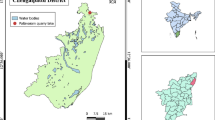Abstract
The role of gas vacuoles in the vertical stratification of planktonic bacteria is analysed. Measurements made with certain gas-vacuolate bacteria in laboratory culture suggest that only colonial forms could sink or float fast enough to form population maxima in lakes by vertical migration from other depths. It is suggested that in the case of individual cells the importance of the buoyancy provided by gas vacuoles is to minimise sinking rates and thereby to increase residence times of the organisms at depths where conditions support their growth.
Changes in the vertical distribution of a number of gas-vacuolate bacteria were followed throughout the year in a monomictic, eutrophic lake (Crose Mere, Shropshire). All were restricted to the anaerobic hypolimnion which developed in summer. The various species formed maxima at different depths and times. With some of them (e.g. species of Thiopedia, Pelonema and Brachyarcus) growth was necessary to explain their development. In others (e. g. species of Pelodictyon and two colourless bacteria) vertical migrations might also have contributed to their development.
Similar content being viewed by others
References
Brock, T. D., Brock, M. L., Bott, T. L., Edwards, M. R.: Microbial life at 90° C: the sulphur bacteria of Boulder Spring. J. Bacteriol. 107, 303–314 (1971)
Caldwell, D. E., Tiedje, J. M.: A morphological study of anaerobic bacteria from the hypolimnia of two Michigan lakes. Can. J. Microbiol. 21, 362–376 (1975a)
Caldwell, D. E., Tiedje, J. M.: The structure of anaerobic bacterial communities in the hypolimnia of several Michigan lakes. Can. J. Microbiol. 21, 377–385 (1975b)
Clark, A. E.: The ecology and physiology of gas-vacuolate bacteria. Ph. D. Thesis, Univ. Wales (1977)
Clark, A. E., Walsby, A. E.: The occurrence of gas-vacuolate bacteria in lakes. Arch. Microbiol. 118, 223–228 (1978)
Gorlenko, V. M., Kuznetsov, S. I.: Über die photosynthesierenden Bakterien des Kononjer-Sees. Arch. Hydrobiol. 70, 1–13 (1972)
Pfennig, N.: Anreicherungskulturen für rote und grüne Schwefelbakterien. Zentbl. Bakt. Parasitkde. I. Abt. Orig. Suppl. 1, 179–189 (1965)
Pfennig, N., Cohen-Bazire, G.: Some properties of the green bacterium Pelodictyon clathratiforme. Arch. Microbiol. 59, 226–236 (1967)
Walsby, A. E.: Structure and function of gas vacuoles. Bact. Rev. 36, 1–32 (1972)
Walsby, A. E.: A portable apparatus for measuring relative gasvacuolation, the strength of gas vacuoles, and turgor pressure in planktonic blue-green algae and bacteria. Limnol. Oceanogr. 18, 653–658 (1973)
Walsby, A. E., Klemer, A. R.: The role of gas vacuoles in the microstratification of a population of Oscillatoria agardhii var. Isothrix in Deming Lake, Minnesota. Arch. Hydrobiol. 74, 375–392 (1974)
Walsby, A. E., Reynolds, C. S.: Sinking and floating in phytoplankton ecology. In: The ecology of phytoplankton (I. Morris, ed.). Oxford: Blackwells (in press)
Author information
Authors and Affiliations
Rights and permissions
About this article
Cite this article
Clark, A.E., Walsby, A.E. The development and vertical distribution of populations of gas-vacuolate bacteria in a eutrophic, monomictic lake. Arch. Microbiol. 118, 229–233 (1978). https://doi.org/10.1007/BF00429110
Received:
Issue Date:
DOI: https://doi.org/10.1007/BF00429110




